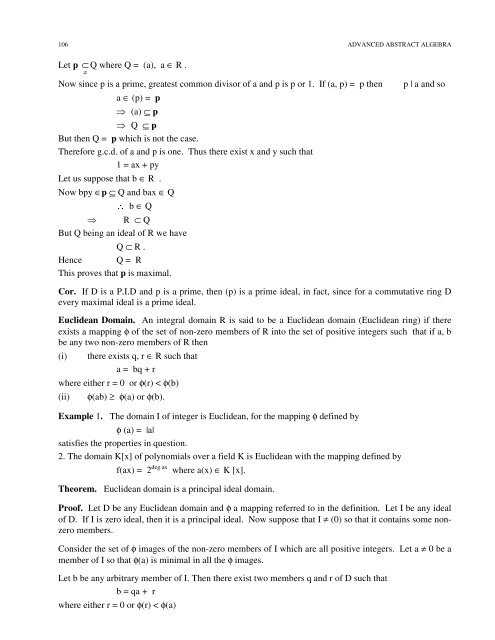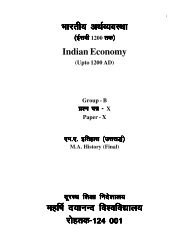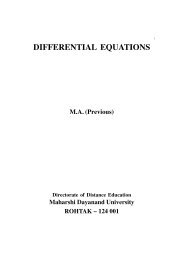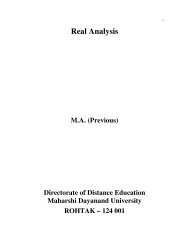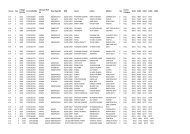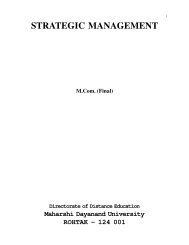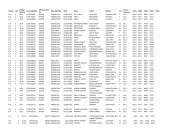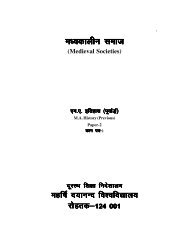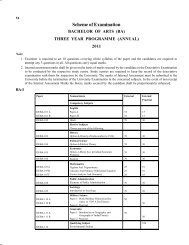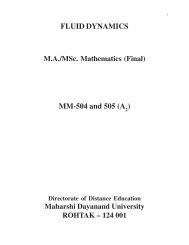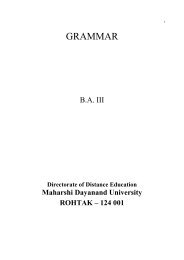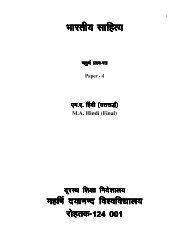Advanced Abstract Algebra - Maharshi Dayanand University, Rohtak
Advanced Abstract Algebra - Maharshi Dayanand University, Rohtak
Advanced Abstract Algebra - Maharshi Dayanand University, Rohtak
You also want an ePaper? Increase the reach of your titles
YUMPU automatically turns print PDFs into web optimized ePapers that Google loves.
106<br />
ADVANCED ABSTRACT ALGEBRA<br />
Let p<br />
≠<br />
⊂ Q where Q = (a), a ∈ R .<br />
Now since p is a prime, greatest common divisor of a and p is p or 1. If (a, p) = p then<br />
a ∈ (p) = p<br />
(a) ⊆ p<br />
Q ⊆ p<br />
But then Q = p which is not the case.<br />
Therefore g.c.d. of a and p is one. Thus there exist x and y such that<br />
1 = ax + py<br />
Let us suppose that b ∈ R .<br />
Now bpy ∈p ⊆ Q and bax ∈ Q<br />
∴ b ∈ Q<br />
R ⊂ Q<br />
But Q being an ideal of R we have<br />
Q ⊂ R .<br />
Hence Q = R<br />
This proves that p is maximal.<br />
p | a and so<br />
Cor. If D is a P.I.D and p is a prime, then (p) is a prime ideal, in fact, since for a commutative ring D<br />
every maximal ideal is a prime ideal.<br />
Euclidean Domain. An integral domain R is said to be a Euclidean domain (Euclidean ring) if there<br />
exists a mapping φ of the set of non-zero members of R into the set of positive integers such that if a, b<br />
be any two non-zero members of R then<br />
(i)<br />
there exists q, r ∈ R such that<br />
a = bq + r<br />
where either r = 0 or φ(r) < φ(b)<br />
(ii)<br />
φ(ab) ≥ φ(a) or φ(b).<br />
Example 1. The domain I of integer is Euclidean, for the mapping φ defined by<br />
φ (a) = |a|<br />
satisfies the properties in question.<br />
2. The domain K[x] of polynomials over a field K is Euclidean with the mapping defined by<br />
deg ax<br />
f(ax) = 2 where<br />
a(x) ∈ K [x].<br />
Theorem. Euclidean domain is a principal ideal domain.<br />
Proof. Let D be any Euclidean domain and φ a mapping referred to in the definition. Let I be any ideal<br />
of D. If I is zero ideal, then it is a principal ideal. Now suppose that I ≠ (0) so that it contains some nonzero<br />
members.<br />
Consider the set of φ images of the non-zero members of I which are all positive integers. Let a ≠ 0 be a<br />
member of I so that φ(a) is minimal in all the φ images.<br />
Let b be any arbitrary member of I. Then there exist two members q and r of D such that<br />
b = qa + r<br />
where either r = 0 or φ(r) < φ(a)


